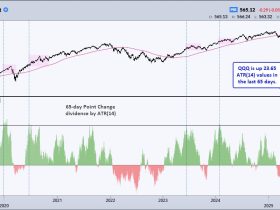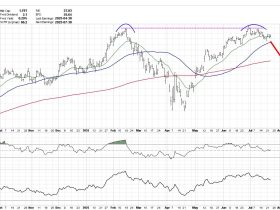The weaker-than-expected jobs report gave the stock market some direction, a nice treat before the 150th Kentucky Derby. Job growth slowed, and the unemployment rate ticked up to 3.9%. If this trend continues, the market may price in more than one interest rate cut this year.
This week’s price action gives the impression that the stock market is still uncertain and can’t decide which way it wants to go. It’s unclear whether Friday’s move is enough to carry the market higher.
The broader equity market indexes moved higher on the news. The Dow Jones Industrial Average ($INDU) and S&P 500 ($SPX) reached their 50-day simple moving average (SMA) but didn’t close above that level. The Nasdaq Composite ($COMPQ) managed to move above its 50-day SMA as several tech stocks moved higher; however, the index didn’t show much upside conviction.
Tech Back in the Lead
The daily chart of the Technology Select Sector SPDR ETF (XLK) below shows the breakout from the recent downtrend. It will be interesting to see if XLK can break through the resistance of its 50-day SMA.
CHART 1. DAILY CHART OF XLK. The ETF broke its recent short-term downtrend, but a breakout above its 50-day SMA is critical.Chart source: StockCharts.com. For educational purposes.
The rotation back into the tech sector shows that investors are still gravitating toward technology stocks. Apple (AAPL) may have helped ignite interest when it reported better-than-expected earnings. Apple’s stock price experienced a steep downfall, which may have now reversed.
Apple’s price shows strength after its significant gap up, following the earnings report (see chart below). The StockCharts Technical Ranking (SCTR) score (upper panel) is moving higher and is now shy of 50. Its Relative Strength Index (RSI) is also close to the 70 level. This would be a stock to add to your ChartList.
CHART 2. APPLE SOARS AFTER EARNINGS REPORT. Will the rise in Apple’s stock price have enough momentum and follow through to push it higher?Chart source: StockCharts.com. For educational purposes.
Shares of Nvidia Corp. (NVDA), Microsoft (MSFT), Amazon (AMZN), and Meta (META) are trading higher. If you want to add more tech stocks to your portfolio, you may want to wait to see some follow-through to the upside before jumping in.
The Big Picture
The market pretty much made up the losses for the week, but the broader equity indexes haven’t pushed through their resistance levels. They climbed higher in the early trading hours, but stalled and stayed relatively flat for most of the trading day. Anyone who was watching the markets will know it was like watching paint dry for most of the day. It is Friday, and investors may not want to add positions, especially since the market looked like it was in correction territory this week.
The Dow gapped up in the early trading hours, but hung out at its 50-day SMA. The S&P 500 broke out to the upside of what looks like a bear flag formation, but it also hung on to its 50-day SMA. The Nasdaq Composite is looking the most bullish of the three indexes, as it broke above its 50-day SMA but hung out there.
Even bond prices were stagnant. The daily chart of the iShares 20+ Year Treasury Bond ETF (TLT) shows that bond prices rose, but didn’t move much for most of the trading day.
CHART 3. DAILY CHART OF TLT. Bonds prices rose on Friday, but still have a long way to go before showing signs of an uptrend.Chart source: StockCharts.com. For educational purposes.
The good news: The CBOE Volatility Index ($VIX) is back below 15 levels, an indication that investors aren’t necessarily fearful and the market didn’t fade at the close.
There’s not much economic data next week. There are a few earnings to pay attention to, but a big chunk is in the rear-view mirror. The market could continue its indecisive behavior next week. We’ll have to wait and see. It may be a good time to put your stock market thoughts aside and shift your focus to watching the Derby.
End-of-Week Wrap-Up
S&P 500 closes up 1.26% at 5127.78, Dow Jones Industrial Average up 1.18% at 38,675.88; Nasdaq Composite up 1.99% at 16,156.33$VIX down 7.97% at 13.51Best performing sector for the week: UtilitiesWorst performing sector for the week: EnergyTop 5 Large Cap SCTR stocks: Super Micro Computer, Inc. (SMCI); Vistra Energy Corp. (VST); Vertiv Holdings (VRT); MicroStrategy Inc. (MSTR); Coinbase Global Inc. (COIN)
On the Radar Next Week
Several Fed speechesEarnings from Berkshire Hathaway (BRK/B) reporting on Saturday, BioNTech (BNTX), Walt Disney (DIS), Palantir Technologies (PLTR), and Duke Energy (DUK), Uber (UBER), among others.
Disclaimer: This blog is for educational purposes only and should not be construed as financial advice. The ideas and strategies should never be used without first assessing your own personal and financial situation, or without consulting a financial professional.







